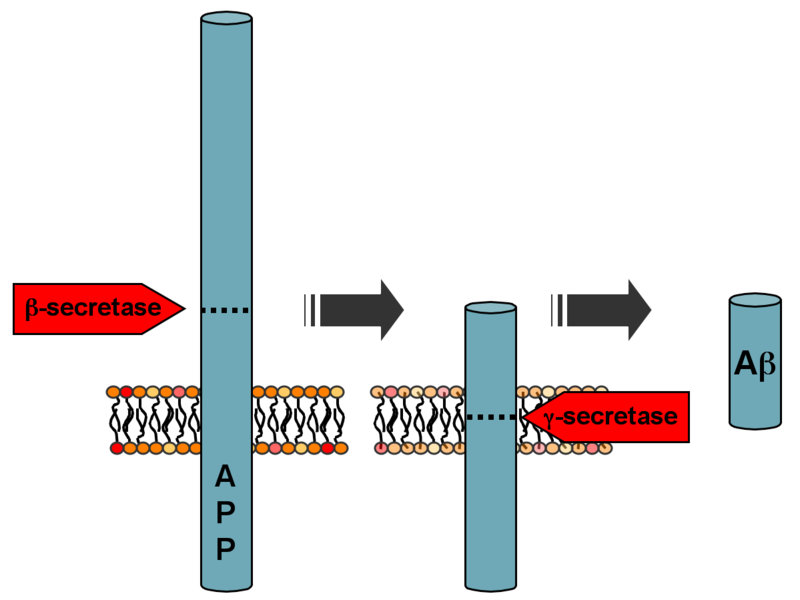Amyloid beta
| amyloid beta (A4) precursor protein (peptidase nexin-II, Alzheimer disease) | |
|---|---|
 Processing of the amyloid precursor protein | |
| Identifiers | |
| Symbol | APP |
| Alt. symbols | AD1 |
| Entrez | 351 |
| HUGO | 620 |
| OMIM | 104760 |
| RefSeq | NM_000484 |
| UniProt | P05067 |
| Other data | |
| Locus | Chr. 21 q21.2 |
Overview
Amyloid beta (Aβ or Abeta) is a peptide of 39-43 amino acids that is the main constituent of amyloid plaques in the brains of Alzheimer's disease patients. Similar plaques appear in some variants of Lewy body dementia and in inclusion body myositis, a muscle disease. Aβ also forms aggregates coating cerebral blood vessels in cerebral amyloid angiopathy. These plaques are composed of a tangle of regularly ordered fibrillar aggregates called amyloid fibers, a protein fold shared by other peptides such as prions associated with protein misfolding diseases.
Formation
Aβ is formed after sequential cleavage of the amyloid precursor protein (APP), a transmembrane glycoprotein of undetermined function. APP can be processed by α-, β- and γ-secretases; Aβ protein is generated by successive action of the β and γ secretases. The γ secretase, which produces the C-terminal end of the Aβ peptide, cleaves within the transmembrane region of APP and can generate a number of isoforms of 39-43 amino acid residues in length. The most common isoforms are Aβ40 and Aβ42; the shorter form is typically produced by cleavage that occurs in the endoplasmic reticulum, while the longer form is produced by cleavage in the trans-Golgi network.[1]. The Aβ40 form is the more common of the two, but Aβ42 is the more fibrillogenic and is thus associated with disease states. Mutations in APP associated with early-onset Alzheimer's have been noted to increase the relative production of Aβ42, and thus one suggested avenue of Alzheimer's therapy involves modulating the activity of β and γ secretases to produce mainly Aβ40.[2]
Genetics
Autosomal-dominant mutations in APP cause hereditary early-onset Alzheimer's disease, likely as a result of altered proteolytic processing. Increases in either total Aβ levels or the relative concentration of both Aβ40 and Aβ42 (where the former is more concentrated in cerebrovascular plaques and the latter in neuritic plaques)[3] have been implicated in the pathogenesis of both familial and sporadic Alzheimer's disease. Due its more hydrophobic nature, the Aβ42 is the most amyloidogenic form of the peptide. However the central sequence KLVFFAE is known to form amyloid on its own, and probably forms the core of the fibril.
The "amyloid hypothesis", that the plaques are responsible for the pathology of Alzheimer's disease, is accepted by the majority of researchers but is by no means conclusively established. Intra-cellular deposits of tau protein are also seen in the disease, and may also be implicated. The oligomers that form on the amyloid pathway, rather than the mature fibrils, may be the cytotoxic species.[4]
Intervention strategies
Researchers in Alzheimer's disease have identified five strategies as possible interventions against amyloid:[5]
- β-Secretase inhibitors. These work to block the first cleavage of APP outside of the cell.
- γ-Secretase inhibitors. These work to block the second cleavage of APP in the cell membrane and would then stop the subsequent formation of Aβ and its toxic fragments.
- Selective Aβ-42 lowering agents. These modulate γ-secretase to reduce Aβ-42 production in favor of other (shorter) Aβ versions.
- Immunotherapies. These stimulate the host immune system to recognize and attack Aβ or provide antibodies that either prevent plaque deposition or enhance clearance of plaques.
- Anti-aggregation agents. These prevent Aβ fragments from aggregating or clear aggregates once they are formed.
Measuring Amyloid beta
There are many different ways to measure Amyloid beta. One highly sensitive method is ELISA which is an immuno-sandwich assay which utilizes a pair of antibodies that recognize Amyloid beta. Another, highly sensitive technology is AlphaLISA which is a no wash ELISA technology based on antibody coated beads.
External link
References
- ↑ Nature Medicine 3(9):1016-1020 (1997)
- ↑ Yin YI, Bassit B, Zhu L, Yang X, Wang C, Li YM. (2007). Gamma -secretase substrate concentration modulates the abeta 42/abeta 40 ratio: Implications for Alzheimer's disease. J Biol Chem. Epub. PMID 17556361
- ↑ The American Journal of Pathology; Lue, L; 155(3):853-662 (1999)
- ↑ Kayed R et al, Common Structure of Soluble Amyloid Oligomers implies Common Mechanism of Pathogenesis Science 300 : 486-489
- ↑ Citron, M. Strategies for disease modification in Alzheimer's disease. Nat Rev Neurosci., 2004, Vol 5 pp. 677-685 PMID 15322526